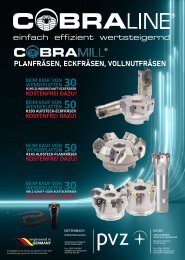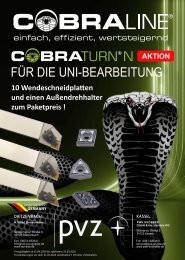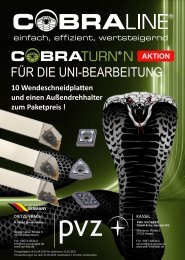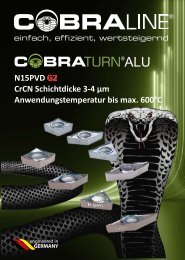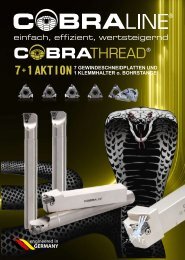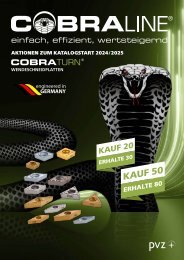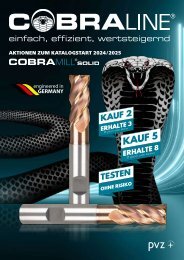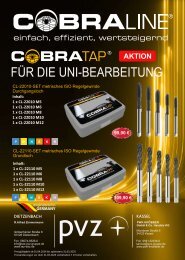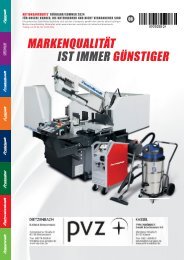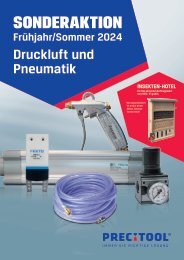- Seite 1 und 2:
WERKZEUGKATALOG 2022/24 TOOL CATALO
- Seite 3 und 4:
Zwei starke Partner - eine gestärk
- Seite 5 und 6:
Immer die RICHTIGE LÖSUNG PRECITOO
- Seite 7 und 8:
BEREIT- SCHAFTS- DIENST FÜR WERKZE
- Seite 9 und 10:
Auf die Achse FERTIG. LOS! Wir gara
- Seite 11 und 12:
WIN WIN- Effekte inklusive Beispiel
- Seite 13 und 14:
Werkzeugauswahl Tool Selection Im R
- Seite 15 und 16:
Werkzeug-Identnummern-Verzeichnis
- Seite 17 und 18:
Die Unternehmen · The Companies 5
- Seite 19 und 20:
Gewindebohrer · Taps Gewindebohrer
- Seite 21 und 22:
Gewindebohrer · Taps Product Finde
- Seite 23 und 24:
Rekord A-STEEL Rekord B-STEEL-L Rek
- Seite 25 und 26:
Rekord A-GJV-IKZ PM-TICN Rekord A-G
- Seite 27 und 28:
Rekord DF-TILEG TICN Rekord C-NI-PM
- Seite 29 und 30:
Rekord A-Z-IKZ-LF4 TICN Rekord B-Z-
- Seite 31 und 32:
Enorm Z GLT-1 Enorm Z-IKZ GLT-1 Eno
- Seite 33 und 34:
AUT-A KOMBI KEG Product Finder AUT-
- Seite 35 und 36:
Gewindebohrer · Taps Product Finde
- Seite 37 und 38:
Maschinen-Gewindebohrer · Machine
- Seite 39 und 40:
Maschinen-Gewindebohrer · Machine
- Seite 41 und 42:
Maschinen-Gewindebohrer · Machine
- Seite 43 und 44:
Maschinen-Gewindebohrer · Machine
- Seite 45 und 46:
Maschinen-Gewindebohrer · Machine
- Seite 47 und 48:
Maschinen-Gewindebohrer · Machine
- Seite 49 und 50:
Maschinen-Gewindebohrer · Machine
- Seite 51 und 52:
Maschinen-Gewindebohrer · Machine
- Seite 53 und 54:
Maschinen-Gewindebohrer · Machine
- Seite 55 und 56:
Maschinen-Gewindebohrer · Machine
- Seite 57 und 58:
Maschinen-Gewindebohrer · Machine
- Seite 59 und 60:
Maschinen-Gewindebohrer · Machine
- Seite 61 und 62:
Maschinen-Gewindebohrer · Machine
- Seite 63 und 64:
Maschinen-Gewindebohrer · Machine
- Seite 65 und 66:
Maschinen-Gewindebohrer · Machine
- Seite 67 und 68:
Maschinen-Gewindebohrer · Machine
- Seite 69 und 70:
Maschinen-Gewindebohrer · Machine
- Seite 71 und 72:
Maschinen-Gewindebohrer · Machine
- Seite 73 und 74:
Maschinen-Gewindebohrer · Machine
- Seite 75 und 76:
Maschinen-Gewindebohrer · Machine
- Seite 77 und 78:
Maschinen-Gewindebohrer · Machine
- Seite 79 und 80:
Maschinen-Gewindebohrer · Machine
- Seite 81 und 82:
Maschinen-Gewindebohrer · Machine
- Seite 83 und 84:
Hartmetall-Satz-Gewindebohrer · Ca
- Seite 85 und 86:
Satz-Kombinationen · Set Combinati
- Seite 87 und 88:
Satz-Kombinationen · Set Combinati
- Seite 89 und 90:
Satz-Kombinationen · Set Combinati
- Seite 91 und 92:
Maschinen-Kombi-Gewindebohrer · Ma
- Seite 93 und 94:
Maschinen-Gewindebohrer · Machine
- Seite 95 und 96:
Maschinen-Gewindebohrer · Machine
- Seite 97 und 98:
Maschinen-Gewindebohrer · Machine
- Seite 99 und 100:
Maschinen-Gewindebohrer · Machine
- Seite 101 und 102:
Maschinen-Gewindebohrer · Machine
- Seite 103 und 104:
Maschinen-Gewindebohrer · Machine
- Seite 105 und 106:
Maschinen-Gewindebohrer · Machine
- Seite 107 und 108:
Maschinen-Gewindebohrer · Machine
- Seite 109 und 110:
Maschinen-Gewindebohrer · Machine
- Seite 111 und 112:
Maschinen-Gewindebohrer · Machine
- Seite 113 und 114:
Maschinen-Gewindebohrer · Machine
- Seite 115 und 116:
Maschinen-Gewindebohrer · Machine
- Seite 117 und 118:
Maschinen-Gewindebohrer · Machine
- Seite 119 und 120:
Satz-(Hand-)Gewindebohrer · Sets o
- Seite 121 und 122:
Hartmetall-Satz-Gewindebohrer · Ca
- Seite 123 und 124:
Satz-Kombinationen · Set Combinati
- Seite 125 und 126:
Maschinen-Kombi-Gewindebohrer · Ma
- Seite 127 und 128:
Maschinen-Gewindebohrer · Machine
- Seite 129 und 130:
Maschinen-Gewindebohrer · Machine
- Seite 131 und 132:
Maschinen-Gewindebohrer · Machine
- Seite 133 und 134:
Satz-(Hand-)Gewindebohrer · Sets o
- Seite 135 und 136:
Satz-Kombinationen · Set Combinati
- Seite 137 und 138:
Maschinen-Gewindebohrer · Machine
- Seite 139 und 140:
Maschinen-Gewindebohrer · Machine
- Seite 141 und 142:
Maschinen-Gewindebohrer · Machine
- Seite 143 und 144:
Satz-(Hand-)Gewindebohrer · Sets o
- Seite 145 und 146:
Satz-Kombinationen · Set Combinati
- Seite 147 und 148:
Maschinen-Gewindebohrer · Machine
- Seite 149 und 150:
Maschinen-Gewindebohrer · Machine
- Seite 151 und 152:
Maschinen-Gewindebohrer · Machine
- Seite 153 und 154:
Maschinen-Gewindebohrer · Machine
- Seite 155 und 156:
Maschinen-Gewindebohrer · Machine
- Seite 157 und 158:
Satz-(Hand-)Gewindebohrer · Sets o
- Seite 159 und 160:
Satz-Kombinationen · Set Combinati
- Seite 161 und 162:
Maschinen-Gewindebohrer · Machine
- Seite 163 und 164:
Kurze Automatengewindebohrer für D
- Seite 165 und 166:
Maschinen-Gewindebohrer · Machine
- Seite 167 und 168:
Maschinen-Gewindebohrer · Machine
- Seite 169 und 170:
Maschinen-Gewindebohrer · Machine
- Seite 171 und 172:
Maschinen-Gewindebohrer · Machine
- Seite 173 und 174:
Maschinen-Gewindebohrer · Machine
- Seite 175 und 176:
Maschinen-Gewindebohrer · Machine
- Seite 177 und 178:
Maschinen-Gewindebohrer · Machine
- Seite 179 und 180:
Maschinen-Gewindebohrer · Machine
- Seite 181 und 182:
Maschinen-Gewindebohrer · Machine
- Seite 183 und 184:
Maschinen-Gewindebohrer · Machine
- Seite 185 und 186:
Maschinen-Gewindebohrer · Machine
- Seite 187 und 188:
Satz-(Hand-)Gewindebohrer · Sets o
- Seite 189 und 190:
Maschinen-Gewindebohrer · Machine
- Seite 191 und 192:
Maschinen-Gewindebohrer · Machine
- Seite 193 und 194:
Maschinen-Gewindebohrer · Machine
- Seite 195 und 196:
Maschinen-Gewindebohrer · Machine
- Seite 197 und 198:
Maschinen-Gewindebohrer · Machine
- Seite 199 und 200:
Maschinen-Gewindebohrer · Machine
- Seite 201 und 202:
Maschinen-Gewindebohrer · Machine
- Seite 203 und 204:
Maschinen-Gewindebohrer · Machine
- Seite 205 und 206:
Maschinen-Gewindebohrer · Machine
- Seite 207 und 208:
Maschinen-Gewindebohrer · Machine
- Seite 209 und 210:
Maschinen-Gewindebohrer · Machine
- Seite 211 und 212:
Maschinen-Gewindebohrer · Machine
- Seite 213 und 214:
Trapez-Einschnitt-Gewindebohrer ·
- Seite 215 und 216:
Trapez-Einschnitt-Gewindebohrer ·
- Seite 217 und 218:
Rund-Gewindebohrer · Round Thread
- Seite 219 und 220:
Kühlschmierstoffe · Coolant-Lubri
- Seite 221 und 222:
Spezial-Schaftverlängerungen · Sp
- Seite 223 und 224:
Verstellbare Windeisen · Adjustabl
- Seite 225 und 226:
Gewindebohrer · Taps Technische In
- Seite 227 und 228:
Gewindebohrer · Taps 1.2 Gewindebo
- Seite 229 und 230:
Gewindebohrer · Taps 1.3 EMUGE Gew
- Seite 231 und 232:
Gewindebohrer · Taps 1.4 EMUGE Geo
- Seite 233 und 234:
Gewindebohrer · Taps 1.4 EMUGE Geo
- Seite 235 und 236:
Gewindebohrer · Taps 1.5 EMUGE Obe
- Seite 237 und 238:
Gewindebohrer · Taps 1.6 Sonstige
- Seite 239 und 240:
Gewindebohrer · Taps 1.8 Kühl- un
- Seite 241 und 242:
Gewindebohrer · Taps 1.10 Toleranz
- Seite 243 und 244:
Gewindebohrer · Taps 1.11 Berechnu
- Seite 245 und 246: Gewindebohrer · Taps 1.13 Technisc
- Seite 247 und 248: Gewindeformer · Cold-Forming Taps
- Seite 249 und 250: Product Finder v c M Drück STEEL C
- Seite 251 und 252: Product Finder v c M InnoForm GAL-S
- Seite 253 und 254: Gewindeformer · Cold-Forming Taps
- Seite 255 und 256: Maschinen-Gewindeformer · Cold-For
- Seite 257 und 258: Maschinen-Gewindeformer · Cold-For
- Seite 259 und 260: Maschinen-Gewindeformer · Cold-For
- Seite 261 und 262: Maschinen-Gewindeformer · Cold-For
- Seite 263 und 264: Maschinen-Gewindeformer · Cold-For
- Seite 265 und 266: Maschinen-Gewindeformer · Cold-For
- Seite 267 und 268: Maschinen-Gewindeformer · Cold-For
- Seite 269 und 270: Maschinen-Gewindeformer · Cold-For
- Seite 271 und 272: Maschinen-Gewindeformer · Cold-For
- Seite 273 und 274: Maschinen-Gewindeformer · Cold-For
- Seite 275 und 276: Maschinen-Gewindeformer · Cold-For
- Seite 277 und 278: SELF-LOCK Maschinen-Gewindeformer
- Seite 279 und 280: Gewindeformer · Cold-Forming Taps
- Seite 281 und 282: Gewindeformer · Cold-Forming Taps
- Seite 283 und 284: Gewindeformer · Cold-Forming Taps
- Seite 285 und 286: Gewindeformer · Cold-Forming Taps
- Seite 287 und 288: Gewindeformer · Cold-Forming Taps
- Seite 289 und 290: Gewindeformer · Cold-Forming Taps
- Seite 291 und 292: Gewindeformer · Cold-Forming Taps
- Seite 293 und 294: Gewindeformer · Cold-Forming Taps
- Seite 295: Gewindeformer · Cold-Forming Taps
- Seite 299 und 300: Spannzangen-Aufnahmen und Schnellwe
- Seite 301 und 302: Spannzangen-Aufnahmen und Schnellwe
- Seite 303 und 304: Spannzangen-Aufnahmen · Collet Hol
- Seite 305 und 306: Schnellwechsel-Aufnahmen · Quick-C
- Seite 307 und 308: Spannzangen-Aufnahmen · Collet Hol
- Seite 309 und 310: Spannzangen-Aufnahmen · Collet Hol
- Seite 311 und 312: Spannzangen-Aufnahmen · Collet Hol
- Seite 313 und 314: Spannzangen-Aufnahmen · Collet Hol
- Seite 315 und 316: Schnellwechsel-Aufnahmen · Quick-C
- Seite 317 und 318: Spannzangen-Aufnahmen · Collet Hol
- Seite 319 und 320: Dichtscheiben und Kühlscheiben ·
- Seite 321 und 322: Spannmuttern · Clamping Nuts Produ
- Seite 323 und 324: Montagevorrichtung · Assembly Devi
- Seite 325 und 326: Aufsteckschlüssel für Drehmoments
- Seite 327 und 328: Spannzangen-Aufnahmen und Schnellwe
- Seite 329 und 330: Spannzangen-Aufnahmen und Schnellwe
- Seite 331 und 332: Spannzangen-Aufnahmen und Schnellwe
- Seite 333 und 334: Spannzangen-Aufnahmen und Schnellwe
- Seite 335 und 336: Spannzangen-Aufnahmen und Schnellwe
- Seite 337 und 338: Spannzangen-Aufnahmen und Schnellwe
- Seite 339 und 340: Spannzangen-Aufnahmen und Schnellwe
- Seite 341 und 342: Hartmetall-Schaft- und Langlochfrä
- Seite 343 und 344: ER Product Finder NF N H WR W v c /
- Seite 345 und 346: ER ER Product Finder NF N H WR W v
- Seite 347 und 348:
ER ER ER ER ER ER Product Finder NF
- Seite 349 und 350:
ER ER ER R3D R3D ER ER Product Find
- Seite 351 und 352:
ER ER ER ER Product Finder NF N H W
- Seite 353 und 354:
Hartmetall-Schaftfräser · Solid C
- Seite 355 und 356:
Hartmetall-Schaftfräser · Solid C
- Seite 357 und 358:
Hartmetall-Schaftfräser · Solid C
- Seite 359 und 360:
Hartmetall-Schaftfräser „DUPLEX
- Seite 361 und 362:
l 2 l 1 Hartmetall-Schaftfräser ·
- Seite 363 und 364:
Hartmetall-Schaftfräser · Solid C
- Seite 365 und 366:
Hartmetall-Schaftfräser · Solid C
- Seite 367 und 368:
Hartmetall-Micro- und Mini-Schaftfr
- Seite 369 und 370:
Hartmetall-Schaftfräser · Solid C
- Seite 371 und 372:
Hartmetall-Langlochfräser · Solid
- Seite 373 und 374:
Hartmetall-Schaftfräser · Solid C
- Seite 375 und 376:
Hartmetall-Schaftfräser „ENORM
- Seite 377 und 378:
Hartmetall-Schaftfräser „ENORM
- Seite 379 und 380:
Hartmetall-Schaftfräser „ENORM
- Seite 381 und 382:
Hartmetall-Schaftfräser „ENORM
- Seite 383 und 384:
Hartmetall-Schaftfräser „Base“
- Seite 385 und 386:
Hartmetall-Schaftfräser · Solid C
- Seite 387 und 388:
Hartmetall-Schaftfräser · Solid C
- Seite 389 und 390:
Hartmetall-Schaftfräser · Solid C
- Seite 391 und 392:
Hartmetall-Schaftfräser „Trochoi
- Seite 393 und 394:
Hartmetall-Schaftfräser „Trochoi
- Seite 395 und 396:
Hartmetall-Schaftfräser · Solid C
- Seite 397 und 398:
Hartmetall-Schaftfräser · Solid C
- Seite 399 und 400:
Hartmetall-Schaftfräser · Solid C
- Seite 401 und 402:
Hartmetall-Schaftfräser · Solid C
- Seite 403 und 404:
Hartmetall-Schaftfräser · Solid C
- Seite 405 und 406:
Hartmetall-Schaftfräser „Aerospa
- Seite 407 und 408:
Hartmetall-Schaftfräser · Solid C
- Seite 409 und 410:
Hartmetall-Schaftfräser „Aerospa
- Seite 411 und 412:
Hartmetall-Schaftfräser · Solid C
- Seite 413 und 414:
Hartmetall-Schaftfräser · Solid C
- Seite 415 und 416:
Schnittwerte · Cutting Conditions
- Seite 417 und 418:
Schnittwerte · Cutting Conditions
- Seite 419 und 420:
Schnittwerte · Cutting Conditions
- Seite 421 und 422:
Schnittwerte · Cutting Conditions
- Seite 423 und 424:
Schnittwerte · Cutting Conditions
- Seite 425 und 426:
Schnittwerte · Cutting Conditions
- Seite 427 und 428:
Schnittwerte · Cutting Conditions
- Seite 429 und 430:
Schnittwerte · Cutting Conditions
- Seite 431 und 432:
Schnittwerte · Cutting Conditions
- Seite 433 und 434:
Schnittwerte · Cutting Conditions
- Seite 435 und 436:
Schnittwerte · Cutting Conditions
- Seite 437 und 438:
Schnittwerte · Cutting Conditions
- Seite 439 und 440:
Schnittwerte · Cutting Conditions
- Seite 441 und 442:
Schnittwerte · Cutting Conditions
- Seite 443 und 444:
Schnittwerte · Cutting Conditions
- Seite 445 und 446:
Schnittwerte · Cutting Conditions
- Seite 447 und 448:
Schnittwerte · Cutting Conditions
- Seite 449 und 450:
Hartmetall-Kugel- und Torusfräser
- Seite 451 und 452:
Hartmetall-Micro- und Mini-Kugelfr
- Seite 453 und 454:
Hartmetall-Kugelfräser Solid carbi
- Seite 455 und 456:
Hartmetall-Torusfräser Solid carbi
- Seite 457 und 458:
Hartmetall-Micro- und Mini-Kugelfr
- Seite 459 und 460:
Hartmetall-Kugelfräser · Solid Ca
- Seite 461 und 462:
Hartmetall-Kugelfräser · Solid Ca
- Seite 463 und 464:
Hartmetall-Kugelfräser „Lollipop
- Seite 465 und 466:
Hartmetall-Kugelfräser · Solid Ca
- Seite 467 und 468:
Hartmetall-Kugelfräser · Solid Ca
- Seite 469 und 470:
Hartmetall-Kugelfräser · Solid Ca
- Seite 471 und 472:
Hartmetall-Kugelfräser · Solid Ca
- Seite 473 und 474:
Hartmetall-Kugelfräser · Solid Ca
- Seite 475 und 476:
Hartmetall-Micro- und Mini-Torusfr
- Seite 477 und 478:
Hartmetall-Micro- und Mini-Torusfr
- Seite 479 und 480:
Hartmetall-Torusfräser · Solid Ca
- Seite 481 und 482:
Hartmetall-Torusfräser · Solid Ca
- Seite 483 und 484:
Hartmetall-Torusfräser · Solid Ca
- Seite 485 und 486:
Hartmetall-Torusfräser · Solid Ca
- Seite 487 und 488:
Hartmetall-Torusfräser · Solid Ca
- Seite 489 und 490:
Schnittwerte · Cutting Conditions
- Seite 491 und 492:
Schnittwerte · Cutting Conditions
- Seite 493 und 494:
Schnittwerte · Cutting Conditions
- Seite 495 und 496:
Schnittwerte · Cutting Conditions
- Seite 497 und 498:
Schnittwerte · Cutting Conditions
- Seite 499 und 500:
Schnittwerte · Cutting Conditions
- Seite 501 und 502:
Schnittwerte · Cutting Conditions
- Seite 503 und 504:
Schnittwerte · Cutting Conditions
- Seite 505 und 506:
PKD-, CBN- und diamantbeschichtete
- Seite 507 und 508:
Diamantbeschichtete Hartmetall-Frä
- Seite 509 und 510:
CBN-Fräser CBN end mills Kugel Tor
- Seite 511 und 512:
Hartmetall-Schaftfräser · Solid C
- Seite 513 und 514:
Hartmetall-Kugelfräser · Solid Ca
- Seite 515 und 516:
PKD-Schaftfräser · PCD End Mills
- Seite 517 und 518:
PKD-Kugelfräser · PCD Ball Nose E
- Seite 519 und 520:
PKD-Plan- und Eckfräser · PCD Sid
- Seite 521 und 522:
CBN-Kugelfräser · CBN Ball Nose E
- Seite 523 und 524:
CBN-Micro- und Mini-Kugelfräser ·
- Seite 525 und 526:
CBN-Micro- und Mini-Torusfräser ·
- Seite 527 und 528:
Schnittwerte · Cutting Conditions
- Seite 529 und 530:
Schnittwerte · Cutting Conditions
- Seite 531 und 532:
Schnittwerte · Cutting Conditions
- Seite 533 und 534:
Kreissegment- und konische Hartmeta
- Seite 535 und 536:
Hartmetall-Kreissegment-Fräser Sol
- Seite 537 und 538:
Konische Hartmetall-Torusfräser Ta
- Seite 539 und 540:
Hartmetall-Kreissegment-Fräser ·
- Seite 541 und 542:
2 /2 Hartmetall-Kreissegment-Fräse
- Seite 543 und 544:
Hartmetall-Kreissegment-Fräser ·
- Seite 545 und 546:
2 Hartmetall-Kreissegment-Fräser
- Seite 547 und 548:
Konische Hartmetall-Kugelfräser ·
- Seite 549 und 550:
Konische Hartmetall-Kugelfräser ·
- Seite 551 und 552:
Konische Hartmetall-Kugelfräser ·
- Seite 553 und 554:
Konische Hartmetall-Torusfräser ·
- Seite 555 und 556:
2 Konische Hartmetall-Torusfräser
- Seite 557 und 558:
Konische Hartmetallfräser · Taper
- Seite 559 und 560:
Schnittwerte · Cutting Conditions
- Seite 561 und 562:
Schnittwerte · Cutting Conditions
- Seite 563 und 564:
Schnittwerte · Cutting Conditions
- Seite 565 und 566:
Schnittwerte · Cutting Conditions
- Seite 567 und 568:
Schnittwerte · Cutting Conditions
- Seite 569 und 570:
Schnittwerte · Cutting Conditions
- Seite 571 und 572:
Schnittwerte · Cutting Conditions
- Seite 573 und 574:
Schnittwerte · Cutting Conditions
- Seite 575 und 576:
Schnittwerte · Cutting Conditions
- Seite 577 und 578:
Wende- und Wechselschneidplattenfr
- Seite 579 und 580:
Time-S4-Cut Time-S-Cut Fräskörper
- Seite 581 und 582:
Runde Wendeschneidplatten Round ins
- Seite 583 und 584:
Torus-Wechselschneidplatten Torus i
- Seite 585 und 586:
l 2 l 1 Fräskörper für Time-S4-C
- Seite 587 und 588:
Time-S-Cut-Wendeschneidplatten · T
- Seite 589 und 590:
Fräskörper für Time-S-Cut-Wendes
- Seite 591 und 592:
Rhombische Wendeschneidplatten · R
- Seite 593 und 594:
Fräskörper für rhombische Wendes
- Seite 595 und 596:
Runde Wendeschneidplatten · Round
- Seite 597 und 598:
Fräskörper für runde Wendeschnei
- Seite 599 und 600:
Fräskörper für Kugel-Wechselschn
- Seite 601 und 602:
Kreissegment-Wechselschneidplatten
- Seite 603 und 604:
Torus-Wechselschneidplatten · Toru
- Seite 605 und 606:
l 3 l 1 l 3 l 1 Fräskörper für T
- Seite 607 und 608:
l 2 l 1 l 3 l 1 3° 3° Fräskörpe
- Seite 609 und 610:
Schnittwerte · Cutting Conditions
- Seite 611 und 612:
Schnittwerte · Cutting Conditions
- Seite 613 und 614:
Schnittwerte · Cutting Conditions
- Seite 615 und 616:
Schnittwerte · Cutting Conditions
- Seite 617 und 618:
Schnittwerte · Cutting Conditions
- Seite 619 und 620:
HSS-Schaft- und Langlochfräser ·
- Seite 621 und 622:
e8 e8 Product Finder NR NF N HR WR
- Seite 623 und 624:
e8 ER ER Product Finder NR NF N HR
- Seite 625 und 626:
ER ER ER ER Product Finder NR NF N
- Seite 627 und 628:
HSS-Schaftfräser · HSS End Mills
- Seite 629 und 630:
HSS-Schaftfräser · HSS End Mills
- Seite 631 und 632:
HSS-Langlochfräser · HSS Slot Dri
- Seite 633 und 634:
HSS-Mini-Langlochfräser · HSS Min
- Seite 635 und 636:
HSS-Langlochfräser · HSS Slot Dri
- Seite 637 und 638:
HSS-Langlochfräser · HSS Slot Dri
- Seite 639 und 640:
HSS-Schaftfräser · HSS End Mills
- Seite 641 und 642:
HSS-Schaftfräser · HSS End Mills
- Seite 643 und 644:
HSS-Schaftfräser · HSS End Mills
- Seite 645 und 646:
HSS-Schaftfräser · HSS End Mills
- Seite 647 und 648:
HSS-Schaftfräser · HSS End Mills
- Seite 649 und 650:
HSS-Schaftfräser · HSS End Mills
- Seite 651 und 652:
HSS-Schaftfräser · HSS End Mills
- Seite 653 und 654:
HSS-Schaftfräser · HSS End Mills
- Seite 655 und 656:
HSS-Schaftfräser · HSS End Mills
- Seite 657 und 658:
HSS-Schaftfräser · HSS End Mills
- Seite 659 und 660:
Schnittwerte · Cutting Conditions
- Seite 661 und 662:
Schnittwerte · Cutting Conditions
- Seite 663 und 664:
Schnittwerte · Cutting Conditions
- Seite 665 und 666:
Schnittwerte · Cutting Conditions
- Seite 667 und 668:
Schnittwerte · Cutting Conditions
- Seite 669 und 670:
Schnittwerte · Cutting Conditions
- Seite 671 und 672:
Schnittwerte · Cutting Conditions
- Seite 673 und 674:
HSS- und Hartmetall-Schaftformfräs
- Seite 675 und 676:
HSS-Kugelfräser HSS ball nose end
- Seite 677 und 678:
HSS-Schlitzfräser HSS Woodruff key
- Seite 679 und 680:
HSS-Kugelfräser · HSS Ball Nose E
- Seite 681 und 682:
HSS-Kugelfräser · HSS Ball Nose E
- Seite 683 und 684:
Hartmetall-NC-Entgratfräser · Sol
- Seite 685 und 686:
Hartmetall-Gravierstichel · Solid
- Seite 687 und 688:
HSS-Viertelrund-Profilfräser · HS
- Seite 689 und 690:
HSS-T-Nutenfräser · HSS T-Slot En
- Seite 691 und 692:
HSS-Winkelfräser · HSS Dovetail E
- Seite 693 und 694:
HM-Kegelsenker · Carbide Countersi
- Seite 695 und 696:
Hartmetall-Frässtifte tall räss t
- Seite 697 und 698:
Hartmetall-Frässtifte · Carbide B
- Seite 699 und 700:
Schnittwerte · Cutting Conditions
- Seite 701 und 702:
Schnittwerte · Cutting Conditions
- Seite 703 und 704:
Schnittwerte · Cutting Conditions
- Seite 705 und 706:
Schnittwerte · Cutting Conditions
- Seite 707 und 708:
Schnittwerte · Cutting Conditions
- Seite 709 und 710:
Fräser mit Bohrung · Milling Cutt
- Seite 711 und 712:
HSS-Walzenstirnfräser HSS shell en
- Seite 713 und 714:
HSS-Metallkreissägeblätter HSS me
- Seite 715 und 716:
HSS-Walzenstirnfräser · HSS Shell
- Seite 717 und 718:
HSS-Walzenstirnfräser · HSS Shell
- Seite 719 und 720:
Schmale HSS-Scheibenfräser · Narr
- Seite 721 und 722:
Hartmetall-Metallkreissägeblätter
- Seite 723 und 724:
HSS-Metallkreissägeblätter · HSS
- Seite 725 und 726:
HSS-Aufsteck-Winkelstirnfräser ·
- Seite 727 und 728:
Zahnformfräser · Spur Wheel Milli
- Seite 729 und 730:
Schnittwerte · Cutting Conditions
- Seite 731 und 732:
Schnittwerte · Cutting Conditions
- Seite 733 und 734:
Schnittwerte · Cutting Conditions
- Seite 735 und 736:
HA HB kompatibel A B extra kurz kur
- Seite 737 und 738:
Beschreibung der Symbole · Descrip
- Seite 739 und 740:
Beschreibung der Symbole · Descrip
- Seite 741 und 742:
Beschreibung der Produktlinien · D
- Seite 743 und 744:
Beschreibung der Produktlinien · D
- Seite 745 und 746:
Zylinderschäfte · Straight Shanks
- Seite 747 und 748:
Mögliche Modifikationen an Fräser
- Seite 749 und 750:
Schneidendurchmesser-Toleranzen ·
- Seite 751 und 752:
Werkzeug-Identnummern-Verzeichnis
- Seite 753 und 754:
Werkzeug-Identnummern-Verzeichnis
- Seite 755:
Bestell-Code-Verzeichnis · Index o
- Seite 758:
Ihr Precitool-Händler: R. Alfred Z





